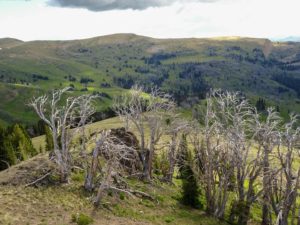
As we approached 9000 feet on the third day of our first backpacking trip, we entered a new ecosystem unknown to our group. Forests dominated by spruce and firs ceded into another forest dweller—the whitebark pine (pinus albicaulis). Only found within high-elevation environments, this tree is remarkable in every sense. Witnessing impacts to the species firsthand was profound. We discussed management implications and the species’ future only ten feet away from the very trees at risk. Learning in such an environment was powerful, and led us all to have a deeper connection to the issues at stake. We got an up-close look at the invasive fungus threatening the whitebark’s future, and we could see on their bark patterns of holes left from pine beetles. We walked through a forest with a disrupted fire cycle that threatens the species, and later on our backpacking trip, a forest of dead trees painted a line between mountain-adapted whitebark pines and their fight against a fungus and beetles that come from lower elevations. Down valley, we looked upon densely-packed spruce and lodgepole forests that told a different story. Without fire, the whitebark pine faces more competition from other conifers, and is in closer proximity to other pines that may pass on beetle infestations. The dead twisted trunks that we walked through reminded us of how much we have to lose.
These trees can’t move any higher. As climate change increases temperatures at high elevations, they are running out of terrain to spread to. At the same time, whitebarks face a native pine beetle they never evolved with—the pine species the beetle loves are often found at lower elevations, and other tree species have historically acted as a buffer to prevent infestations from spreading higher into whitebark territory. Unfortunately, changes in fire and climate mean that species such as lodgepole pines grow in closer proximity to the higher mountain pine. Combined with a white pine fungus that sickens trees and stunts growth, whitebarks are under attack on many fronts. Additionally, whitebarks are a slow growing species and may not even produce a single cone for fifty years (sometimes not fully producing cones for 250 years). This life history strategy is functional in the tree’s previous ecology, but it makes nursery and sapling returns difficult. The loss of the whitebark pine is the result of a perfect ecological storm—and an extremely unfortunate situation. The species is a key member of high mountain ecosystems. We risk losing more than a species if we lose the whitebark.
What will happen to the bears who survive off their cones year-round? Or what will happen when bears no longer visit mountainous regions—will berry seeds in their scat continue to supplement the patches of summery fruits? Or what about the snowdrifts the trees generate in their wake during winter? Will downstream spring snowmelt run faster and shorter? Will whitewater recreation and fishing change? The loss of these trees will have profound impacts that we can only begin to understand. We are at risk of losing a remarkable species.
Find out more at whitebarkfound.org
Jayden Skelly is a student at Western Colorado University studying environmental biology and ecology with a focus in wildlife and geospatial analysis.